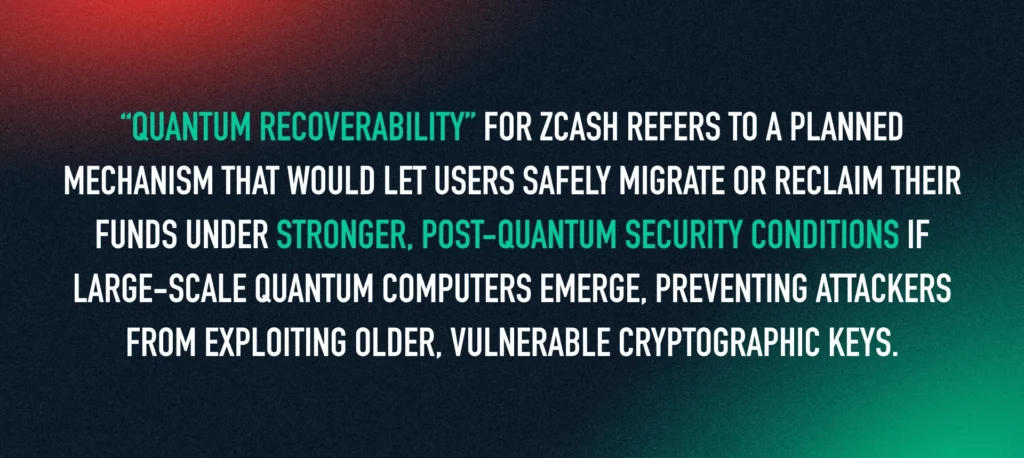
24 Nov How is Zcash Mitigating the Risks of Quantum Computing?
Zcash faces the same long-term cryptographic pressures as other blockchain networks, but its design gives it a distinct position in the wider quantum-risk landscape. Quantum computing threatens systems that expose public keys or rely heavily on elliptic-curve assumptions, and many blockchains fall into this category. Zcash’s shielded architecture reduces this exposure by keeping key transactional details off-chain, which limits how much a quantum adversary could reconstruct from historical data. Even so, Zcash is not immune: components such as signatures, proof verification, and note encryption still depend on pre-quantum primitives that could eventually be broken. Developers are addressing these weaknesses through projects like Tachyon, which removes secret-sharing methods vulnerable to harvest-now-decrypt-later attacks, and by researching post-quantum alternatives for proofs and key exchange. Complementing this work is “quantum recoverability,” a mechanism intended to let users re-secure their funds under stronger cryptographic conditions if quantum threats arrive unexpectedly early. Together, these efforts illustrate a deliberate, staged approach to quantum preparedness, positioning Zcash ahead of many networks while acknowledging that substantial work remains to reach full post-quantum security.
Can Zcash Hold Up Under a Potential Quantum Computing Attack?
In our recent article about the threat to digital assets posed by quantum computing, we took a general look at some of the risks and possible mitigations digital assets could employ to become “quantum resistant”. This week we’re taking a look at Zcash’s quantum risk profile and potential mitigations.
A quick recap: Quantum computing poses a long-term challenge to most blockchain systems because many depend on public-key cryptography that quantum algorithms such as Shor’s could eventually break. If a sufficiently powerful quantum computer emerges, it could derive private keys from exposed public keys, forge signatures, or undermine proof systems that rely on elliptic curve assumptions. This creates both forward-looking risks and retroactive ones, since blockchains store all historical data openly; attackers can harvest encrypted material today and decrypt it later when hardware improves. For most networks, this risk spans both integrity and confidentiality, particularly for chains in which public keys or other sensitive metadata appear on-chain. While credible quantum attacks are not expected in the immediate future, the uncertainty around timelines has pushed many projects to evaluate their exposure and prepare for post-quantum transitions.
Within this broader purvey, Zcash occupies a somewhat unusual position. Its shielded transaction design already limits the exposure of public keys and metadata, meaning that in many common cases an attacker, even with powerful quantum hardware, cannot retroactively reconstruct sender–receiver relationships from the ledger alone. This offers a degree of present-day resilience that chains like Bitcoin or Ethereum do not have, since their public keys become visible once coins are spent. However, Zcash is not fully insulated from quantum threats. Key components of its protocol, including elliptic curve–based signature schemes, proof verification, and note-encryption mechanisms, ultimately rely on assumptions that a future quantum machine could compromise. The practical level of protection also depends on real-world user behaviour. If users employ transparent addresses, leak metadata, or rely on third-party infrastructure, quantum risks re-enter through these channels even if the shielded pool itself remains structurally difficult to deanonymise.
The primary quantum risks for Zcash fall into two categories, which are, privacy erosion through “harvest now, decrypt later” attacks, and the potential loss of soundness if elliptic-curve assumptions are broken. The former concerns note encryption and other secrets that might one day be decrypted if quantum machines reach scale and the latter concerns counterfeiting or theft if the protocol’s soundness-critical components become vulnerable. Zcash developers acknowledge these risks but distinguish between areas needing immediate attention and those that can be handled through well-timed upgrades. Privacy protections are viewed as the higher priority, since confidentiality compromised after the fact cannot be restored. Soundness risks, while serious, can be mitigated with protocol migrations once clearer quantum timelines emerge, and the Zcash ecosystem has already demonstrated an ability to perform significant upgrades, such as the transition to Halo 2 , without disrupting the network.
Current Zcash mitigation strategies centre on reducing dependence on elliptic-curve assumptions, preparing migration paths to post-quantum cryptography, and introducing mechanisms that allow users to recover or secure funds if quantum capabilities advance faster than expected. Zcash developers are working on “quantum recoverability” techniques for Orchard that would allow users to re-secure their assets under post-quantum conditions without exposing privacy. Project Tachyon aims to eliminate in-band secret distribution in shielded transactions, closing a key avenue for harvest-and-decrypt attacks. Longer-term directions include exploring hash-based proof systems such as STARKs, investigating lattice-based key-exchange replacements like Kyber, and designing cold-storage protocols for users who need long-term resilience. While the transition is complex and still unfolding, Zcash’s architecture and ongoing research provide a clearer pathway to post-quantum adaptation than many other blockchain systems, even as significant work remains to ensure its privacy and soundness endure against future quantum threats.
A Look at How Zcash Developers are Addressing Quantum Computing Risks
Zcash developers are tackling quantum computing risk on several fronts, starting with how the protocol is architected today. From its earliest designs, Zcash tried to avoid tying privacy directly to the strongest and most fragile cryptographic assumptions. Shielded transactions use zero-knowledge proofs, hiding commitments, and symmetric primitives in a way that limits what a future attacker can learn from the chain itself, even if some components are weakened. The team has been careful to isolate elliptic-curve dependencies so that privacy does not collapse the moment one assumption fails. This compartmentalisation shows up in work like ZIP 212, which removed a scenario where breaking SNARK soundness could have leaked information in edge cases, and in the broader design philosophy of keeping privacy as independent as possible from any single cryptographic building block.
On top of this foundation, developers are now actively upgrading the protocol to handle “harvest now, decrypt later” threats and to prepare for a post-quantum world. A major focus is Project Tachyon, which aims to remove in-band secret distribution from shielded transactions. Today, some transaction details that are encrypted under elliptic-curve–based schemes could, in theory, be stored and decrypted decades later by a powerful quantum computer. By restructuring how secrets are shared and eliminating this dependency, Tachyon is intended to make on-chain shielded privacy robust even against retrospective quantum attacks. The long-term goal is that an adversary, no matter how advanced, will not be able to reconstruct sender, receiver, or amount information from the ledger alone, because that data simply never appears in a decryptable form on-chain.
Developers are also working on what they describe as “quantum recoverability” for Zcash funds, particularly within the Orchard shielded pool. “Quantum recoverability” for Zcash refers to a planned mechanism that would let users safely migrate or reclaim their funds under stronger, post-quantum security conditions if large-scale quantum computers emerge, preventing attackers from exploiting older, vulnerable cryptographic keys. The idea is to give users a way to migrate or “rescue” their assets if credible quantum threats emerge sooner than expected, without handing an advantage to attackers. This involves changing how wallets manage keys and how spending conditions are expressed, so that if the community needs to tighten security, by switching to post-quantum conditions or additional checks, honest users can move their funds safely while quantum adversaries cannot easily front-run them. In parallel, the team is considering a dedicated long-term storage mechanism for users holding large balances or very long-horizon savings, allowing them to opt into stronger, more conservative cryptographic protections before quantum hardware matures.

Zcash developers are exploring full post-quantum transitions for the pieces that remain vulnerable: signatures, proof systems, and encryption. On the proving side, that likely means investigating hash-based or STARK-style systems that avoid elliptic curves altogether, while maintaining the performance and succinctness that Zcash relies on. For key agreement and note encryption, lattice-based key encapsulation mechanisms like those standardised by the National Institute of Standards and Technology are natural candidates, though integrating them into mobile wallets and existing circuits is non-trivial. All of this has to be done without breaking auditability or fragmenting the user base, so the team is treating quantum migration as a staged process: harden privacy first, provide recovery paths for funds, and then progressively swap out pre-quantum primitives as mature post-quantum alternatives become practical. The result is not instant “quantum-proofing,” but a roadmap that makes Zcash progressively less dependent on cryptography that quantum computers are expected to weaken.
How Does Zcash Stack Up For Quantum Resistance Against Other Chains?
Zcash compares favourably to many major blockchains in the context of quantum resistance, largely because its shielded pool avoids exposing critical transaction data on-chain. Bitcoin, Ethereum, and most legacy networks rely on elliptic-curve signatures that reveal public keys once a transaction is broadcast. A future quantum machine running Shor’s algorithm could derive the corresponding private keys, making historic funds vulnerable. By contrast, Zcash’s fully shielded transactions do not place sender or receiver public keys on the ledger at all. This structural difference reduces the exposure window for quantum adversaries and provides stronger baseline protection today, even though the underlying cryptography still uses elliptic-curve assumptions.
Compared with other privacy-focused chains, Zcash also holds a distinct position. Monero, for example, uses ring signatures, stealth addresses, and RingCT to obscure transaction flows, but these mechanisms still depend on elliptic-curve cryptography that quantum computers are expected to break. Once elliptic curve cryptography becomes vulnerable, Monero’s anonymity set can be unwound retroactively because ring members and stealth address derivations ultimately rely on discrete-log hardness. That being said, Monero, like Zcash, has a development community already discussing and planning solutions for potential quantum vulnerabilities. Zcash’s shielded pool, by contrast, hides far more information by default. Under careful operational use, meaning only shielded transactions and no metadata leakage, Zcash provides a level of forward confidentiality that many other privacy coins cannot match under the same threat model.

That said, Zcash is not yet fully quantum-resistant. Its zk-SNARK proofs, note encryption, and Orchard circuits still rely on elliptic-curve primitives that would lose soundness once quantum hardware becomes powerful enough. Similarly, transparent Zcash addresses face the same risks as Bitcoin and Ethereum, because their public keys are visible upon use. In this respect, Zcash shares many of the long-term vulnerabilities seen across the industry. What distinguishes it is the narrower attack surface inside the shielded pool and the work already underway to migrate sensitive components to post-quantum alternatives.
In terms of preparation, Zcash is further along than many networks. Its developers have spent years designing the protocol to compartmentalise cryptographic assumptions and to allow components to be swapped out with post-quantum equivalents. Research into “quantum recoverability,” hash-based proof systems, and lattice-based encryption for note confidentiality shows a deliberate strategy to ensure upgrades can be adopted without overhauling the entire architecture. While no public blockchain is fully safe from a future, fault-tolerant quantum computer, Zcash’s design choices and ongoing development roadmap place it among the projects most actively preparing for that transition, and potentially more resilient than chains that rely heavily on exposed public keys and slower governance mechanisms.



